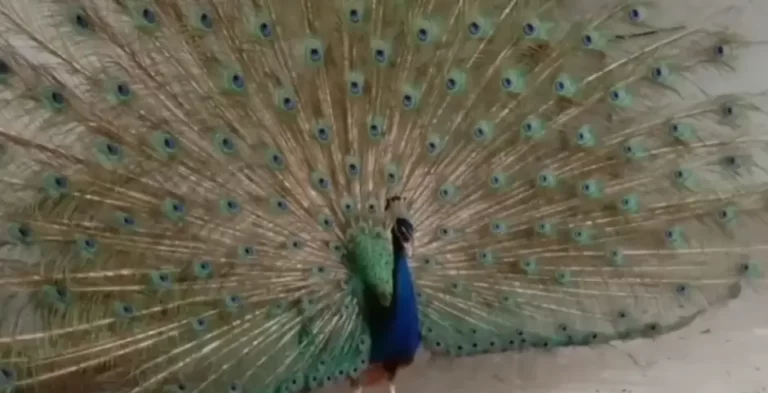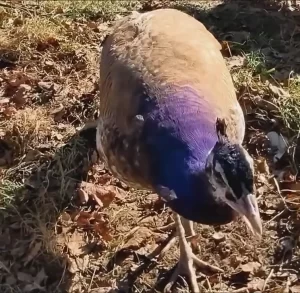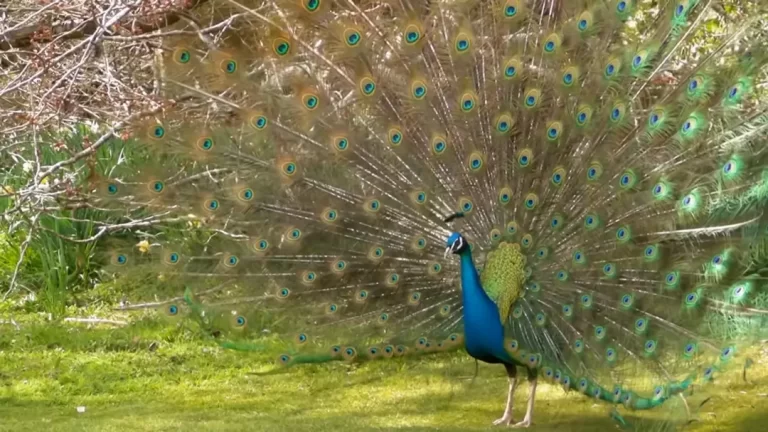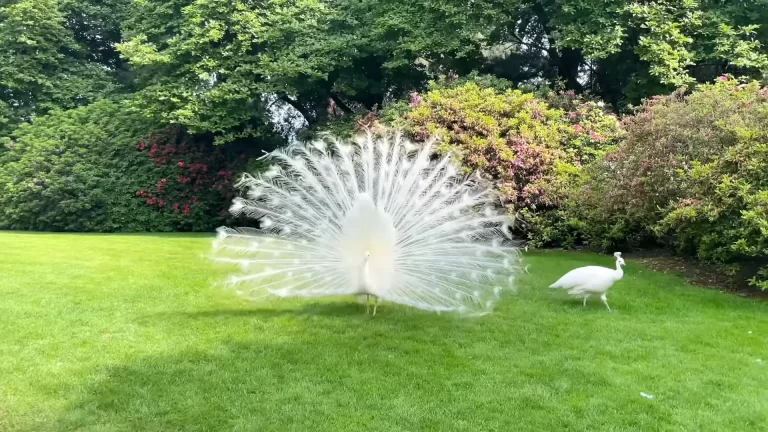Purple Peacocks
The Purple Peacock is a rare type of peacock, not as common as a blue peacock, and it is the prettiest and elegant peacock color. This type of peacock is also known as the Burmese peacock, and is found in Southeast Asia, lives in Burma, Thailand, and some other places in Indonesia. The first purple peacock arrived in Arizona in 1987. That peacock was sold to Rough Wood Aviaries, where efforts were made to develop the mutation, and the team succeeded. In 1994, these peacocks were officially introduced. These peacocks are also big birds; and purple peacocks can grow up to three feet in length, while their purple peahens are smaller.
People claim that they have seen peacocks in different colors, and the only blue peacock is a genuine breed. Most of us have also seen peacocks in common colors such as green and blue. When experts did some research, they found that purple feathered birds exist in reality. These peafowls are typically known as Indian peafowls. Purple is the rarest color that comes due to special genes. It happens once in a million times. They are not naturally found in the forest, and people raise them in specific spots.
They have purple tummies, chests, necks, and heads. Their tails exhibit purple color with the shade of blue. Purple peacocks always display green, blue, or brown shoulders, and on the other hand, the purple peahens have a body from brown to a light creamy white. Some purple peahens may have some green and purple feathers on their neck or head.
They need large, open spaces for running, moving, and playing. They are happy peafowl with feathers that shine in the sun. These purple-feathered birds are amazing and look astonishing in the sunlight. Their unique purple shine in their feathers is due to a genetic change. These peacocks are also noisy, like other peacock breeds that are loud and vocal, but they are normally easy to care for.

Are Purple Peacocks Real or Not?
Yes, these purple peacocks are real and rare in the universe; they were firstborn in 1987 in the state of Arizona. These peacocks are unique, uncommon, and difficult to find. They have a different and special color as compared to the common Indian blue peacock. They are a new type of peacock bred by breeders around the world. This color of peacock is not as common as white peacocks, but with the passing of time, it has become popular.
This bird with purple feathers is a type of peacock from Southeast Asia, specifically found in Myanmar, and it is a subspecies of the Indian peafowl. Purple peacock exhibits a sex-linked mutation, which means that only male peacocks have the purple gene.
Facts about Purple Peacocks
- They are bigger than compared to all peacock breeds
- They mostly grow up to 6 feet tall and weigh 10 pounds.
- They are in danger, people are hunting them because their homes are gone.
- They mostly eat animals and plants.
- Their life span is around 20 years.
- There are different colors and patterns of Indian peafowl including blue and purple.
- Purple feathered birds make a higher-pitched sound, louder than blue peafowls.
Are there different varieties of Peacocks in Purple Color?
The color shade of a peacock is normally decided by their neck color. Even the Indian peacocks have a variety of colors in their plumage, they are known as blue peafowl because of their blue neck. Purple peacocks always have purple necks with many varieties of colors in their feathers.
There are 225 varieties of peacocks according to the United Peacocks Organization (UPO) around the world. Peacocks come in several types with different colors with distinctive body patterns in comparison to each other. Five patterns are named as white-eyed, silver-pied, barred wing (like wild peacocks), black shoulder, and pied.
20 Purple Peacock Varieties
| Purple peacocks’ variety | Purebred/ Hybrid | Identification | Body pattern and other features |
|---|---|---|---|
| Spalding Purple Pied White-Eyed | Hybrid | Purple with white markings White eyes | Purple-pied white-eyed peacock is a type of peacock with common colors. |
| Purple | Purebred | Iridescent tail feathers Purple peafowl are large | Regular (barred wing) |
| Purple Pied White-Eyed | Purebred | Dark purple neck and breast Markings in white color on the body and plume spots | Irregular white markings on their bodies and feather spots (in white color) instead of having multiple dark colors |
| Spalding Purple | Hybrid – a mix of two species (green and Indian peafowl) | White markings on the body and feather spots | Regular (barred wing) |
| Spalding Purple White-Eyed | Hybrid | Plumage: Purple with white markings white eyes | Same as purple white-eyed |
| Spalding Purple Pied | Hybrid | Plumage: Purple with white markings White eyes | Same as purple pied |
| Purple Pied | Purebred | Plumage: Purple with white markings White eyes | Irregular white splotches on the body |
| Purple White-Eyed | Purebred | Eye spots: White spots | Peafowl feathers have white spots |
| Purple Black Shoulder Spalding Pied White-Eyed | Hybrid | Plumage: White markings and black shoulder, White eyes | White-eyed pied purple black shoulder |
| Spalding Purple Silver Pied | Hybrid | Plumage: Purple with silver markings, White eyes | Same as silver pied |
| Purple Silver Pied | Purebred | Plumage: white with irregular patches of purple, White eyes | Mostly white with irregular patches of color. |
| Purple Black Shoulder Pied White-Eyed | Purebred | Plumage: white markings, white throat latch, and purple with black shoulders, White eyes | Combination of black shoulders, white eyes. and pied markings |
| Purple Black Shoulder | Purebred | Plumage: Purple with black shoulders Brown eyes | Solid-colored wings instead of barred wings. |
| Spalding Purple Black Shoulder White-Eyed | Hybrid | Plumage: White markings and eyes, white throat latch, and purple with black shoulders. | White-eyed purple black shoulder |
| Purple Black Shoulder Spalding | Hybrid | Plumage: Purple with black shoulders, Brown eyes | Purple black shoulder. |
| Purple Black Shoulder Pied Spalding | Hybrid | Plumage: Purple with black shoulders and pied markings, Brown eyes | Pied purple black shoulder |
| Purple Black Shoulder Pied | Purebred | Plumage: Purple with black shoulders and irregular patches of white, Brown eyes | Black shoulders and white splotches on its body. |
| Purple Black Shoulder White-Eyed | Purebred | Plumage: Irregular white patches, white eyes, purple with black shoulders | black shoulder purple with white eye spots (ocelli) on feathers |
| Spalding Purple Black Shoulder Silver Pied | Hybrid | Plumage: Purple with black shoulders and silver markings, White eyes | Silver piedpurple black shoulder |
| Silver Pied Purple Black Shoulder | Purebred | Plumage: Purple with black shoulders and silver patches, White eyes | Black shoulders and a body pattern with silver pied. |
How is it different from Normal Peacocks:
The other common types of peacocks typically have blue chests with blue and green patterns on their tails. While purple peacocks always have a stunning shiny purple color on their chest and neck. Blue Indian peacocks have green and blue feathers, while purple feathered birds have a mixture of purple and blue feathers. These purple birds are more beautiful, with unique shiny feathers, and make them stand out from other peafowls. Their magical feather colors can appear to change, depending on how you look at them.

Symbolism
These purple-feathered birds are associated with pride, beauty, royalty, protection, and luck, having spiritual significance in many cultures. In India, peafowl is the symbol of Lord Murugan, and represents love and fertility. In Greek myths, peafowl are represented with the goddess Hera. Goddess Hera typically used peafowl feathers to decorate her chariot.
Purple Peacock Taxonomy
These purple-feathered birds are different from the Indian peacocks. They are considered to be from the family of “Phasianidae“, which includes pheasants and partridges. They are similar to blue peacocks, but they are so special because of their unique color. Furthermore, they symbolize good luck, protection, royalty, and being different.
- Class: Aves (Birds)
- Genus: Pavo
- Kingdom: Animalia (Animals)
- Species: Pavo muticus (Purple Peafowl)
- Phylum: Chordata (Chordates)
- Family: Phasianidae (Partridges, Allies, and Pheasants)
- Phylum: Chordata
- Order: Galliformes (fowl)
Where can you see Purple Peacocks?
This purple-feathered bird, you can see at zoos and bird parks. Some private bird organizations also keep them, and you can view this collection of peacocks from a distance either through cages or in open areas.
Blue peacocks are easy to find. Green peacocks are also not as rare as purple peacocks and are only found in a few Southeast Asian countries. Congo Peacocks are also found only in the Congo basin. Both green and Congo peacocks are not as common as the Indian peafowl.
FAQs:
Conclusion:
Now that we know how rare the purple peacocks are. Purple feathered birds basically come from Southeast Asia. If you have curiosity to see them, you need to travel to India and Sri Lanka. They are also bred in other parts of the world, but you may need to make some effort to find them. This breed of peacocks is bigger than other peacocks. They eat grain, grass, plants and small reptiles. They have a purple neck, chest, and tummy. Their shiny feathers are due to change in genes and shine in the sun.







